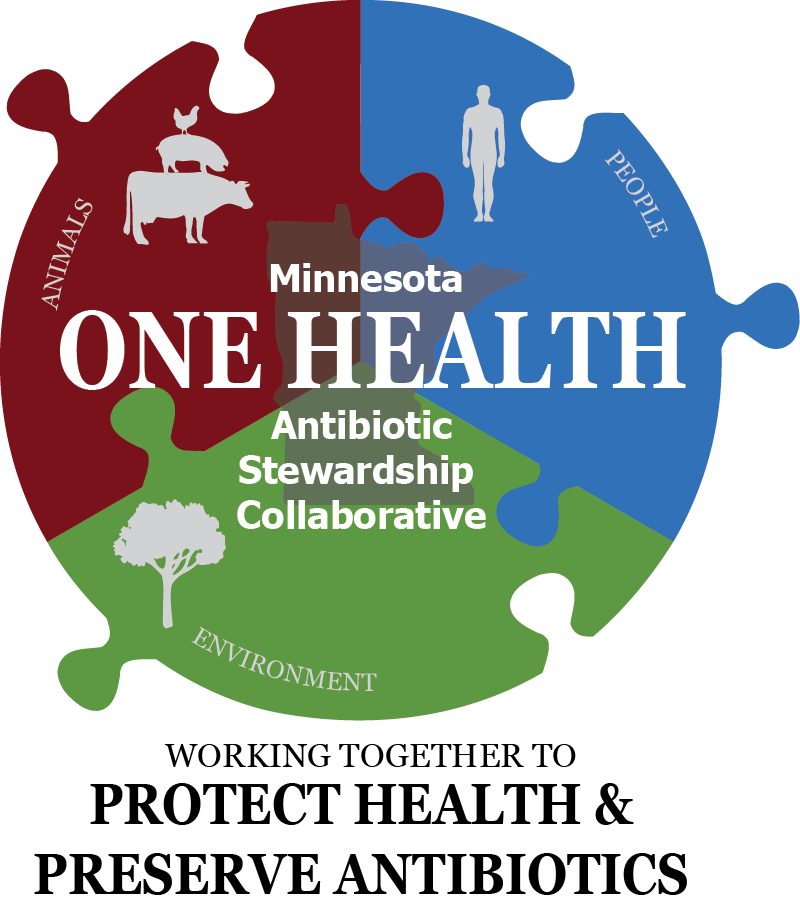Minnesota Department of Health MN Antibiotic Stewardship Collaborative Update Bulletin
Minnesota Department of Health sent this bulletin at 12/07/2016 12:53 PM CST |
Updates and News Alerts from the Minnesota One Health Antibiotic Stewardship Collaborative |
Stewardship quiz? You betcha! (scroll down for answer)
Which of the following describes NARMS, the National Antimicrobial Resistance Monitoring System?
a. CDC surveillance system that tracks susceptibility profiles of intestinal bacteria in people
b. FDA surveillance system that tracks susceptibility profiles of intestinal bacteria on retail meat
c. USDA surveillance system that tracks susceptibility profiles of intestinal bacteria in food animals
d. All of the above
Update from Your Minnesota Stewardship Collaborative
Minnesota's One Health Antibiotic Stewardship Collaborative highlighted on CDC Website
Centers for Disease Control and Prevention (CDC) has launched a new site to support state health departments in implementation of antibiotic stewardship activities. CDC identifies six key components: establish leadership in health departments, conduct surveillance, coordinate and integrate stewardship activities with ongoing quality improvement efforts, convene prevention collaboratives, provide and develop education and tools, develop a communications plan, and inform the legislative process to advance appropriate antibiotic use.
Minnesota's steps to developing the One Health Antibiotic Stewardship Collaborative and Five-year Strategic Plan are highlighted in a one-page fact sheet that can be accessed under the "Establish Leadership" resources.
News to Note
Researchers find carbapenem-resistant Enterobacteriaceae (CRE) associated with metallo-beta-lactamase genes on farrow-to-finish swine farm in Ohio.
- Researchers isolated carbapenemase-producing bacterial isolates harboring the plasmid-associated metallo-beta-lactamase gene, blaIMP-27 from several environmental samples in the farrowing and nursery areas.
- This publication in Antimicrobial Agents and Chemotherapy Journal is the first report of plasmid-associated CRE in a U.S. food agriculture setting.
- Along with other metallo-beta-lactamases, such as VIM and NDM, which convey very broad antibiotic resistance, IMP has been identified in humans in the U.S. in recent years, typically associated with international travel or hospital exposure.
- Much is left unanswered in regard to these findings, including the presence of similar genes on other pig farms, role of human-animal contact in introduction of the genetic resistance elements, likelihood of CRE persistence in a swine population, and the potential impact of cephalosporin use on IMP-27 emergence/maintenance on this farm.
- These findings make real the concern for CRE entry into U.S. food animal systems and necessitate re-doubled efforts to improve antibiotic use in animal and human health sectors, conduct intensive surveillance, and better understand management and environmental factors that contribute to selection of resistant bacteria.
- Healthy people typically do not acquire CRE infections, which usually affect persons in hospitals, healthcare settings, or nursing homes.
- Read the accompanying invited commentary from Tim Johnson, College of Veterinary Medicine, University of Minnesota
Food and Agriculture Organization releases report: "Drivers, Dynamics and Epidemiology of Antimicrobial Resistance in Animal Production".
- FAO's report reviews the scientific and grey literature, reports, and other sources to examine the current state of knowledge on the relationship between animal production and AMR emergence and spread.
Methicillin-Resistant Staphylococcus aureus CC398 in Humans and Pigs in Norway: A "One Health" Perspective on Introduction and Transmission.
- This Clinical Infectious Diseases article describes findings of a study of all CC398 MRSA isolates in humans and animals in Norway during 2008-2014, the majority of which were associated with 3 outbreaks.
- Researchers found that, although pig trade and occupational exposure were primary risk factors for transmission of MRSA CC398 between humans and pigs, human-to-pig transmission was responsible for the initial introductions that led to outbreaks.
-
This paper highlights the importance of biosecurity on farms as well as working together in a one-health approach to address zoonotic pathogens like MRSA.
Multidrug- and Carbapenem-Resistant Pseudomonas aeruginosa in Children, United States, 1999–2012.
- A new article in the Journal of Pediatric Infectious Diseases reports that rates of multidrug resistant and carbapenem-resistant P. aeruginosa infection in children are rising in the U.S.
- Resistant infections were found to be more common in intensive care settings, among children aged 13-17 years, in respiratory specimens, and in the West North Central region of the U.S.
- Authors review cost and revenue elements that should be discussed as part of a stewardship plan.
New CE offering: Antimicrobial Stewardship Initiatives for Asymptomatic Bacteriuria.
- Offered by ProCE and Society of Infectious Diseases Pharmacists
Upcoming Events
Minnesota Antibiotic Stewardship Conference
- Tentative date of March 15, 2017 for this full-day meeting.
-
More details coming soon!
Quiz Answer!
Correct Answer: d. All of the above
The National Antimicrobial Resistance Monitoring System for Enteric Bacteria (NARMS) is a U.S. public health surveillance system, established in 1996. NARMS is a collaboration among state and local public health departments, CDC, the U.S. Food and Drug Administration (FDA), and the U.S. Department of Agriculture (USDA). This national surveillance system tracks changes in the antimicrobial susceptibility of certain intestinal bacteria found in ill people (CDC), retail meats (FDA), and food animals (USDA) in the United States.
Salmonella, Campylobacter, Shigella, E. coli O157, and Vibrio (other than V. cholerae) isolates from human clinical specimens are submitted to CDC NARMS from public health laboratories for antimicrobial sensitivity testing (AST). FDA tracks isolates in retail meat by collecting samples every month from 14 states and conducting AST on Salmonella, Campylobacter, Enterococcus, and E. coli isolates. USDA collects specimens for AST from federally inspected slaughter and processing plants.
Learn more about NARMS on CDC's website, and find links to FDA and USDA NARMS pages.
Handy Links
Minnesota One Health Collaborative
CIDRAP: Antimicrobial Stewardship
USDA: Antimicrobial Resistance
Having trouble viewing this email? View it as a Web page.
